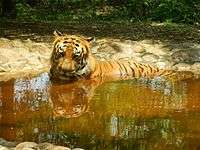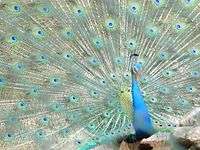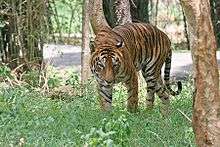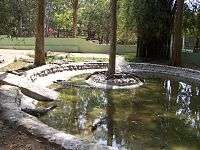Bannerghatta National Park
| Bannerghatta Biological Park | |
|---|---|
|
IUCN category II (national park) | |
 | |
 Bannerghatta Biological Park | |
| Location | Karnataka, India |
| Nearest city | Bangalore |
| Coordinates | 12°48′03″N 77°34′32″E / 12.80083°N 77.57556°ECoordinates: 12°48′03″N 77°34′32″E / 12.80083°N 77.57556°E |
| Area | 260.51 km2 (100.58 sq mi) |
| Established | 1974 |
| Governing body | Ministry of Environment and Forests, Government of India |
|
bannerghattabiologicalpark | |
Bannerghatta National Park, near Bangalore, Karnataka, was founded in 1970 and declared as a national park in 1974.[1] In 2002 a portion of the park, became a biological reserve, the Bannerghatta Biological Park. It is a popular tourist destination with a zoo, a pet corner, an animal rescue centre, a butterfly enclosure, an aquarium, a snake house and a safari park.[2] There are ancient temples in the park for worship and it is a destination for trekking and hiking. The Zoo Authority of Karnataka, the University of Agricultural Sciences, Bangalore, and the Ashoka Trust for Research in Ecology and Environment (ATREE) are collaborating agencies. Within the national park area are six rural villages enclosed within three large enclosures for sheep and cattle farming.[3]
Geography
The 65,127.5 acre (260.51 km2[4]) national park is located about 22 km south of Bangalore in the hills of the Anekal range with an elevation of 1245 - 1634m.[5] The park has a hilly terrain of granite sheets under moist deciduous forest valleys and scrubland on higher areas.[6] Sixteen villages border the park.[7] The park is part of a wildlife corridor for elephants which connects the BR Hills and the Sathyamangalam forest. The park is contiguous with Talli reserve forest in the southeast and Bilikal forest in the south.[3]
Water sources
The park's rainfall is 700 mm per year. The Suvarnamukhi stream runs through the national park. On 15 May 2014, four bore wells were opened to provide water in dry times.[8]
Flora
Flora in the park include:[5]
- Narcissus latifolia
- Schleichera oleosa
- Terminalia tomentosa
- Sandalwood
- Neem
- T. arjuna
- Grewia tilaefolia
- Santalum album
- Tamarind
- Bamboo
- Eucalyptus
- Bauhinia purpurea
- Samanea saman
- Peltphorum pterocarpum
Fauna
Fauna in the park include:[5]

One hundred and one species of birds have been recorded in the park.[9] The fauna pose some risk to humans. In August 2012, a man was trampled to death by an elephant.[10] Occasionally, animals leave the reserve, coming into contact with humans. For example, elephants have been sighted on the Bantamweight-Anekal road which passes close to the park. In 2007, a leopard and her cubs entered a local school.[11]
Biological park

The biological park is a zoological reserve named for Y. M. L Sharma, a Conservator of Forests of Karnataka, who petitioned for the creation of the park. It shelters mammals such as Indian tigers (including white tigers) and lions.
Safari
The park offers safari excursions managed and supported by the Karnataka State Tourist Development Corporation (KSTDC). In late September 2013, the safari was closed for weeks due to an outbreak of foot and mouth disease among the herbivorous animals.[7] The safari includes separate sections for herbivores e.g. spotted dear and carnivores as bears, lions, white tigers and Bengal tigers.
Elephant sanctuary
Bannerghatta is the first biological park in India to have a fenced forested elephant sanctuary where elephants can roam around freely without chains. It is designed by elephant expert Carol Buckley and covers an area of 122 acres.[12] The fence is sponsored by animal rights organization People for the Ethical Treatment of Animals (PETA) India, which raised funds of Rs. 1 crore for its installation. “The elephants are absolutely free to roam without human interference, and will be free of tussles with other wild elephants,” Manilal Valliyate, PETA India's Director of Veterinary Affairs was quoted saying in an interview to The Hindu.[13] According to a report published in Times of India, US elephant expert Margaret Whittaker came up with the innovative idea after visiting BBP last year. She gave the local mahouts training on 'protected contact' with the jumbos. This leads to safe interaction between human beings and elephants by keeping them separated while at the same time using positive techniques to manage the animals.[14]
Zoo
The biological park zoo has a small museum for showcasing special exhibits, a reptile park and a small theatre. In 1992, a fifteen-year-old tiger killed a five-year-old girl who was on safari with her family. The animal was relocated to the zoo. In 2003, authorities found evidence of embezzlement and animal neglect.
Butterfly park
On 25 November 2006, Kapil Sibal, the Union Minister of Science and Technology opened India's first butterfly enclosure at the park. It occupies 7.5 acres (30,000 m2) and houses a butterfly conservatory, a museum, and an audiovisual room. The butterfly conservatory, a circular enclosure with a poly-carbonate roof, is 10,000 sq ft (1,000 m2). Within the conservatory, the environment has been designed to support over twenty species of butterfly. It is a humid tropical climate, with an artificial waterfall and appropriate flora to attract butterflies. The conservatory leads to a second and third dome, which house a museum containing dioramas and exhibits of carefully preserved butterflies.
Gallery
- Bannerghata National Park
 Bengal Tger
Bengal Tger Lion
Lion Lion during Safari
Lion during Safari DancingPeacock
DancingPeacock.jpg) Chital (spotted deer)
Chital (spotted deer) Leopard
Leopard- Lions
- Tiger and lion staring at each other in Bannerghatta National Park
- Tiger
 A white tiger of the Bannerghatta National Park
A white tiger of the Bannerghatta National Park White tiger
White tiger- Tortoise
- Zebra
 Lion
Lion Bengal tiger
Bengal tiger White tiger
White tiger White tiger
White tiger Bengal tiger
Bengal tiger Crocodiles
Crocodiles Indian Crocodile in the Lake of Bannerghatta National Park
Indian Crocodile in the Lake of Bannerghatta National Park Interpretation center
Interpretation center- Bears
 Entrance to the butterfly enclosure
Entrance to the butterfly enclosure Rare spider (family Idiopidae) found in Bannerghatta
Rare spider (family Idiopidae) found in Bannerghatta- Bannerghata National Park - Tiger Safari
- Bannerghata National Park - Safari Entry
 Happy Family
Happy Family
- Bannerghata National Park
 Leopards
Leopards Tiger
Tiger
See also
References
- ↑ "Bannerghatta National Park" Karnataka.com Accessed 23 May 2014.
- ↑ "Bannerghatta Biological Park" Park website Accessed 23 May 2014.
- 1 2 Brondizio E. and Moran E. "Human-Environment Interactions." Springer, 2012 p131 ISBN 9400747802, 9789400747807.
- ↑ Karnataka Government Gazette Notification vide No:FEE302 FWL2011-(11),Bangalore,dated:27-12-2011
- 1 2 3 "Bannerghatta National Park" Bengaloorutourism.com Accessed 24 May 2014.
- ↑ "Bannerghatti national park" Arocha organisation website. Accessed 23 May 2014.
- 1 2 Khanna B. "Safari closed in Bannerghatta zoo due to foot and mouth disease." Bangalore Citizen Accessed 24 May 2014.
- ↑ "Bannerghatta National Park gets four bore wells to quench thirst of animals." The Hindu 15 May 2014. Accessed 24 May 2014.
- ↑ Lepage D. "Bannerghatta National Park bird checklist" Avibase website. Accessed 24 May 2014.
- ↑ Vattam S. "Bannerghatta National Park now open for trekking" newindianexpress.com 21 November 2012. Accessed 24 May 2014.
- ↑ "Sights, sounds and smells from Bangalore: Leopards on prowl on Bannerghatta main road". Bangalorebuzz.blogspot.com 26 September 2007. Accessed 8 May 2014.
- ↑ "PETA, BPA to Create Fenced Forested Sanctuary Together". The New Indian Express. 30 January 2015.
- ↑ "PETA builds electric fence for elephants". The Hindu. 29 January 2015.
- ↑ "Bengaluru to house first fenced elephant sanctuary". Times of India. 30 January 2015.
External links
| Wikimedia Commons has media related to Bannerghatta National Park. |
 Bannerghatta National Park travel guide from Wikivoyage
Bannerghatta National Park travel guide from Wikivoyage- Criticisms of the National Park, The Hindu
- Lions’ club grows at Bannerghatta park
- Butterfly Park, The Hindu
- Rangers in India capture tiger that killed girl, 5. Orlando Sentinel, 15 September 1992.
- Travel Guide to Bannerghatta National Park, Onebangalore.com.
- "Bangalore Bytes". Archived from the original on 4 March 2016. Retrieved 22 June 2017.